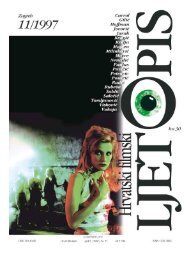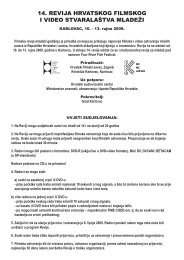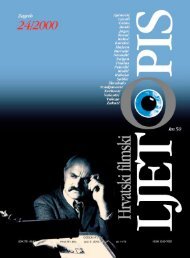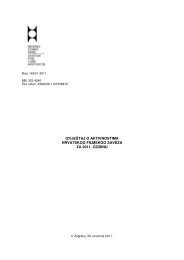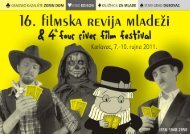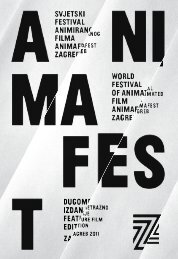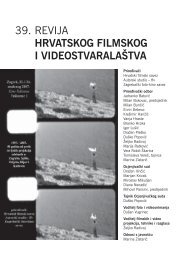You also want an ePaper? Increase the reach of your titles
YUMPU automatically turns print PDFs into web optimized ePapers that Google loves.
Sa`eci Summaries<br />
FILMSKE ZVIJEZDE<br />
Bruno Kragi}<br />
Tipologija `enskih zvijezda ameri~kog<br />
filma<br />
UDK: 791.635-055.2 (73) (091)<br />
Autor razmatra tipologiju `enskih <strong>filmski</strong>h zvijezda, preuzetu od njema~kog<br />
povjesni~ara filma Enna Patalasa koju je potom revidirao i nadopunio<br />
uzimaju}i u obzir i modele tipologija Edgara Morina, Richarda Dyera i<br />
Molly Haskell, Kao prvi izdvaja tip »djevice«, veziv uz Mary Pickford, Lillian<br />
i Dorothy Gish, u razvojnoj liniji prema Shirley Temple i Doris Day, ali<br />
i prema po`rtvovnim i »~istim« junakinjama socijalisti~kih kinematografija,<br />
koje tako, na specifi~an na~in, perpetuiraju taj tip izvan ameri~ke kinematografije.<br />
Slijedi analiza tipa »fatalne `ene«, u razvojnoj liniji od tipa zavodnice<br />
iz kazali{nih melodrama u knji`evnosti devetnaestoga stolje}a preko<br />
Aste Nielsen i Thede Bare do nekih uloga Rite Hayworth, Lane Turner i Veronice<br />
Lake. Tip najvezaniji uz ameri~ku kinematografiju i `anrovski odre-<br />
|en komedijom jest »flapper« — tip povr{ne, neinhibirane djevojke ~iji prikaz<br />
ra~una na potiskivanje prikaza spolnoga i rodnoga identiteta u smjeru<br />
androginije; predstavnice su Clara Bow, Colleen Moore, Louise Brooks<br />
(prije suradnje s G.W.Pabstom) te Joan Crawford, koja markira razvoj toga<br />
tipa prema »dobroj prijateljici« i »mondenki«. Potom se analizira »vamp«,<br />
kao najspecifi~niji tip u Patalasovoj tipologiji; kao predstavnice toga tipa<br />
analiziraju se Greta Garbo, Marlene Dietrich, Mae West i Jean Harlow. U<br />
analizi tipa »mondenke«, ponovno se nagla{ava `anrovska uvjetovanost tipova:<br />
dok se »vamp«, odnosno »fatalna `ena«, proizvodi isklju~ivo unutar<br />
melodrame, »mondenka« destabilizira granicu izme|u melodrame i sofisticirane<br />
komedije, a od 1940-ih istaknuti je tip i unutar trilera. Kao reprezentante<br />
toga tipa autor analizira Gloriju Swanson, te Bette Davis, ali isti~e nestabilne<br />
granice samoga tipa, budu}i da se »mondenka« aktivno preple}e s<br />
tipom »dobre prijateljice« u ulogama reprezentativnih glumica kakve su Lauren<br />
Bacall, Greer Garson i Deborah Kerr, a napose kod zvijezda trilera Alfreda<br />
Hitchcocka — Ingrid Bergman, Grace Kelly i Eve Marie Saint. Sli~na<br />
nestabilnost obilje`ava i tip »dobre prijateljice« I ovaj je tip `anrovski uvjetovan,<br />
budu}i da je karakteristi~an ponajprije za screwball-komedije 1930ih,<br />
a reprezentanti su mu Claudette Colbert, Myrna Loy, Jean Arthur, Carole<br />
Lombard, Katharine Hepburn i Ginger Rogers. Potom se prati raslojavanje<br />
tipa od kraja 1960-ih, koje koincidira s raslojavanjem samoga sustava<br />
zvijezda, ali »dobra prijateljica« bilje`i kontinuitet u 1970-ima u ulogama<br />
Diane Keaton u filmovima Woodyja Allena, te u romanti~nim komedijama<br />
1990-ih. Slijedi analiza tipa vezivoga uz mjuzikle i glazbene komedije<br />
iz 1940-ih i 1950-ih — tzv. »pin-up« — ~iji su reprezentanti Marilyn Monroe,<br />
Betty Grable i Esther Williams. Za »pin-up« je, me|utim, posebno zna-<br />
~ajna Rita Hayworth, kod koje pin-up korespondira s fatalnom `enom. I<br />
posljednji tip, »nimfeta« preispituje granice tipa unutar kojih se konstituira,<br />
budu}i da se mo`e tuma~iti kao izdanak »flappera«, a `anrovski je veziva i<br />
uz melodramu i uz komediju; njezini su reprezentanti Leslie Caron, Audrey<br />
Hepburn i Shirley MacLaine.<br />
FILM STARS<br />
Bruno Kragi}<br />
The Tipology of Female Stars in<br />
American Cinema<br />
UDK: 791.635-055.2 (73) (091)<br />
The author discusses the typology of female film stars taken from German<br />
film historian Enno Patalas, which he has revised and supplemented taking<br />
into consideration typology models constructed by Edgar Morin, Richard<br />
Dyer and Molly Haskell. The first type considered is the »virgin«, linked<br />
with Mary Pickford, Lillian and Dorothy Gish, developing towards Shirley<br />
Temple and Doris Day, but also progressing in the direction of the unselfish<br />
and »pure« heroines of socialist cinema, which perpetuated this type, in<br />
their specific manner. Following is the analysis of the »femme fatale« type,<br />
its line of development starting from the seductress from theatre melodramas<br />
of the 19th century literature, through Asta Nielsen and Theda Bare,<br />
to some of the roles played by Rita Hayworth, Lana Turner and Veronica<br />
Lake. Type that is most particular for the American cinema and generically<br />
determined by comedy is »flapper« — a superficial, fearless girl whose presentation<br />
counts on suppression of sexual and generic identity for the sake<br />
of androgyny; representatives of this type are Clara Bow, Colleen Moore,<br />
Louise Brooks (before she had worked with G. W. Pabst), and Joan<br />
Crawford, who marks the evolution of this type towards a »good friend«<br />
and »independent woman«. Next, the author analyses »vamp« type as the<br />
most particular in Patalas’ typology; representatives of this type are Greta<br />
Garbo, Marlene Dietrich, Mae West and Jean Harlow. In the analysis of the<br />
»independent woman« type, the author again stresses the generic conditioning<br />
of different types: while »vamp«, or the »fatal woman«, lives exclusively<br />
in melodramas, »independent woman« destabilizes the border<br />
between melodrama and sophisticated comedy, and from 1940s becomes a<br />
prominent type in thrillers. The author analyses Gloria Swanson and Bette<br />
Davis as representatives of this type, but stresses the unstable borderlines of<br />
the type, since »independent woman« actively intertwines with the »good<br />
friend« type in the roles of representatives actresses such as Lauren Bacall,<br />
Greer Garson and Deborah Kerr, and particularly in the stars of Alfred<br />
Hitchcock’s thrillers — Ingrid Bergman, Grace Kelly and Eva Marie Saint.<br />
Similar instability marks the »good friend« type, and this type is also generically<br />
conditioned because it is primarily characteristic of screwball comedies<br />
of the 1930s, its representatives being Claudette Colbert, Myrna Loy,<br />
Jean Arthur, Carole Lombard, Katharine Hepburn and Ginger Rogers. The<br />
author than proceeds to the process of layering of the type at the end of<br />
1960s, which coincided with layering of the star system itself, but the<br />
»good friend« continues in the 1970s in Diane Keaton’s roles in Woody<br />
Allen’s films, and romantic comedies of the 1990s. Next is the type linked<br />
with musicals and musical comedies from 1940s and 1950s — the so-called<br />
»pin-up« — whose representatives are Marilyn Monroe, Betty Grable and<br />
Esther Williams. However, Rita Hayworth is particularly significant for the<br />
»pin-up« type because she corresponds with the fatal woman. And the last<br />
type, the »nymphette« questions the borders of the type within which it was<br />
constructed, since it could be seen as the offspring of »flapper«, and generically<br />
could be linked to both melodrama and comedy; its representatives<br />
are Leslie Caron, Audrey Hepburn and Shirley MacLaine.<br />
H R V A T S K I F I L M S K I L J E T O P I S 42/2005.<br />
203









